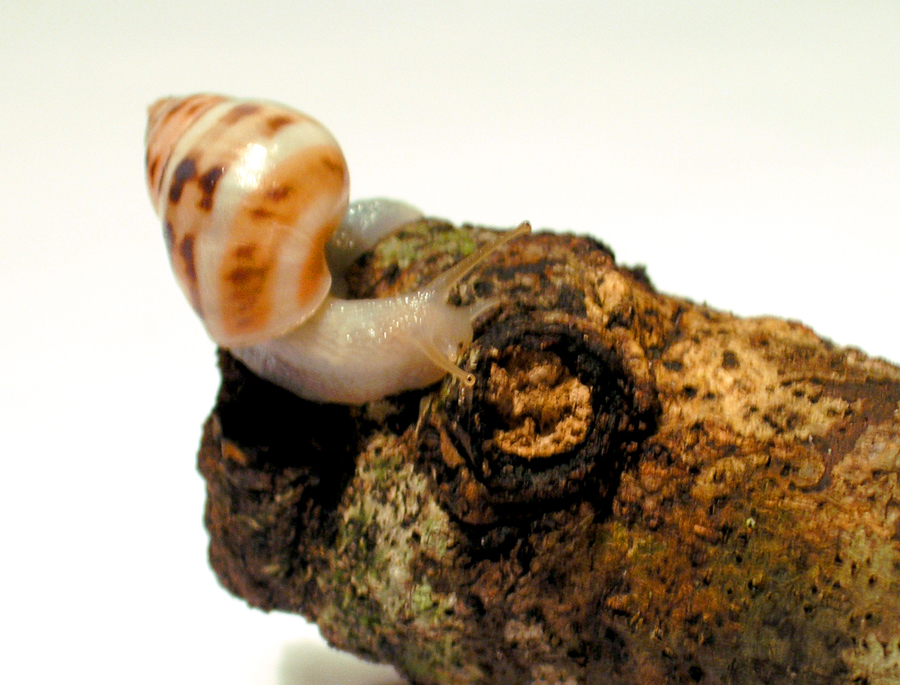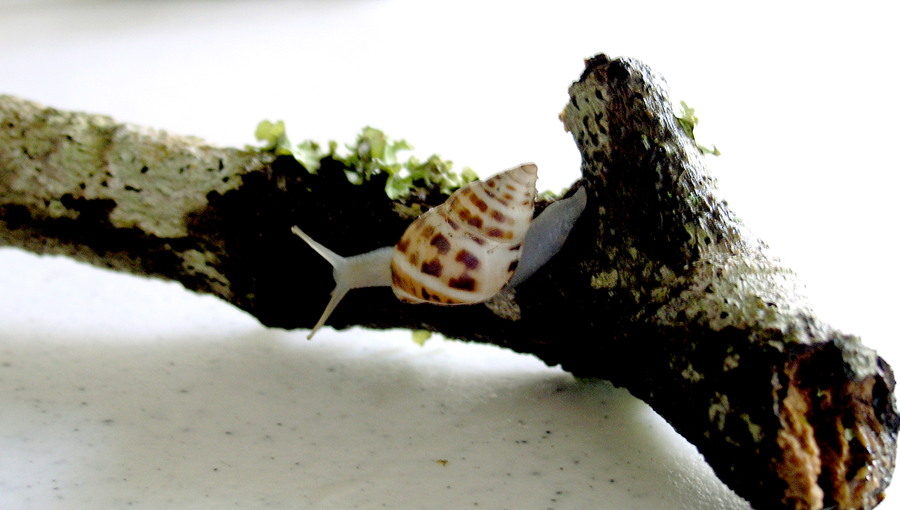The Lighthouse Summer Camp kids and their teachers, Jeff Wessel and Andy Magee, found two Florida tree snails crawling on the Lighthouse patio on August 7, 2007. Why is this worth noting? Florida tree snails normally populate coastal hammocks in South Florida and the Keys. The northernmost area reporting tree snails is Indian River County. There, tree snails have been found on orange and grapefuit trees and since they do no harm to the trees they should not be disturbed.

We created a mini-habitat for our tree snails so we could photograph them and identify the species. It turns out these were both Manatee Tree Snails (Drymaeus dormani). Note details in the photos: spiral shaped shell, white background and 3 to 4 wide red/brown to yellow/brown bands; some bands of brown are broken into vertical designs; these two snails were 2/3s of an inch long. When it emerges, the body seems almost translucent, pale gray.
The Indian River County Extension service remarked that with the lack of freezes since 1989 and plants coming in from South Florida, tree snails have probably been introduced and are adjusting to North Florida habitats and weather.
So far eight native tree snails have been identified in Florida. What’s unique about Florida tree snails, is 1) they live out their entire lives in trees, except when they go to ground to lay eggs; 2) food source: they scrape lichen, fungi, and algae from the trunk of hardwood trees, so they are beneficial and do no harm to plants; 3) they hiberbate: called aestirvation, hibernation is triggered by cooler weather, dry conditions, shorter days. When these conditions occur, the tree snail finds a protected place, usually on its “home tree,” and secretes a mucus which serves to attach it to the tree and to protect it from dehydration during the winter months. If you find a tree snail that looks dead with its aperture shut tight, don’t disturb it; 4) their life span: six to eight years!

But they are lucky if they reach old age. Tree snails have many predators: raccoons, oppossum, birds, rats, and the Rosy Wolf Snail that preys on other snails. As long as the tree snail stays in its tree, it’s relatively safe from the Wolf Snail (it doesn’t like to climb). Spraying for mosquitoes also harms tree snails. The residue from the spray clings to trees and if engested by tree snails will kill them. Habitat destruction in South Florida and over collecting caused these snails to be listed as a “Species of Concern” in Florida.
In South Florida tree snails prefer trees with smooth barks and in Indian River County they have been found in orange and grapefruit trees. If your backyard has lots of trees and a rich diversity, chances are that you may find tree snails there. Sightings in St. Johns County may increase as tree snails, and especially the Manatee Tree Snail move northward. Remember, they do no harm to plants, so share your space with them
Tree snails are hermaphrodites, both male and female, but genetics has proven that mating between individuals occurs anyway during July and August. After mating the snail descends to the ground at the base of its home tree and creates a shallow tunnel or chamber in which it lays two dozen white pea-sized eggs. The next spring warm rains cause the eggs to hatch and the tiny hatched snails make their way to the nearest tree.
If you find a tree snail (usually prefers smooth bark trees in a coastal hammock) in St. Johns County please call Gail Compton, naturalist, at 829-0745, ext 201 and report the finding. If you can photograph the snail or write down a detailed description, it helps. The two snails found at the Lighthouse were released to the LIghthouse coastal hammock the same day they were found.

